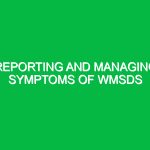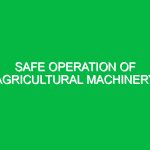Introduction
Safety in Agricultural Work is a critical aspect of the Health, Safety, and Environment (HSE) domain. It encompasses the measures, standards, and practices necessary to protect agricultural workers from hazards inherent to farming and agricultural processes. With agriculture being one of the most hazardous industries globally, it is essential to understand the risks and implement effective safety protocols. This article delves into the various hazards associated with agricultural work, offers actionable safety precautions, and discusses relevant regulations that govern this field.
Understanding Hazards in Agricultural Work
Farming is not just about planting crops or raising livestock; it involves a myriad of tasks that can expose workers to various hazards. These hazards can be categorized into several key areas:
Physical Hazards
Physical hazards are the most common in agricultural work. They include:
- Machinery Accidents: The use of tractors, combines, and other machinery can lead to serious injuries if not operated correctly. A case in point is the tragic story of a farmer who lost his hand while trying to clear a blockage in a combine harvester. This incident underscores the importance of proper training and adherence to safety protocols.
- Slips, Trips, and Falls: Uneven terrain, wet surfaces, and cluttered work areas can lead to accidents. A personal experience shared by a colleague emphasized how a simple trip over a hose resulted in a sprained ankle that sidelined them for weeks.
- Extreme Weather Conditions: Exposure to heat, cold, or storms can pose serious health risks. Farmers often work long hours outdoors, making them vulnerable to heat stroke or hypothermia.
Chemical Hazards
The use of pesticides, herbicides, and fertilizers is commonplace in agriculture, yet these chemicals can be harmful if proper precautions are not taken. For instance, a farmer may unknowingly expose themselves to harmful chemicals by not wearing appropriate protective equipment (PPE). In my own experience, I once witnessed a colleague develop respiratory issues after a day of applying pesticides without a mask.
Biological Hazards
Workers are susceptible to zoonotic diseases, which are diseases that can be transmitted from animals to humans. For example, the risk of contracting Lyme disease from tick bites is a real concern for those working in fields or wooded areas. Additionally, exposure to moldy hay can lead to respiratory conditions such as farmer’s lung.
Ergonomic Hazards
Repetitive motions, heavy lifting, and awkward postures can lead to musculoskeletal disorders. A friend of mine, who has been farming for over a decade, often complains about chronic back pain due to improper lifting techniques. This highlights the need for ergonomic training in agricultural settings.
Safety Precautions and Best Practices
With an understanding of the hazards in agricultural work, it is crucial to implement safety precautions to mitigate risks. Here are some best practices to enhance safety in this domain:
Training and Education
Proper training is vital. Workers should be educated on the safe operation of machinery, chemical handling, and emergency response procedures. Regular safety meetings can reinforce these lessons and keep safety at the forefront of daily operations.
Personal Protective Equipment (PPE)
Wearing appropriate PPE can significantly reduce exposure to hazards. This includes gloves, masks, goggles, and sturdy footwear. For example, during pesticide application, workers should wear long-sleeved clothing and face masks to minimize inhalation and skin contact.
Safe Machinery Practices
Always follow the manufacturer’s instructions for machinery operation. Regular maintenance checks can prevent malfunctions that could lead to accidents. Moreover, never attempt to clear blockages in machinery while it is running, as this is a common cause of injuries.
Emergency Preparedness
Having a clear emergency response plan is crucial. Workers should know the location of first aid kits, fire extinguishers, and emergency contact numbers. Conducting regular drills can ensure that everyone knows their role in case of an emergency.
Ergonomic Solutions
Implementing ergonomic practices can help prevent injuries. For instance, using tools designed to reduce strain, such as long-handled hoes or ergonomic shovels, can promote better posture and reduce the risk of musculoskeletal disorders. Additionally, encouraging breaks and stretching can alleviate physical stress.
Weather Monitoring
Monitoring weather conditions is essential to protect workers from extreme temperatures. Providing water stations, shade, and rest breaks can help prevent heat-related illnesses. Conversely, in cold weather, providing insulated gear and regular breaks indoors can mitigate the risks of hypothermia.
Regulations and Standards in Agricultural Safety
Several regulations govern safety in agricultural work, ensuring that workers are protected from hazards. These include:
Occupational Safety and Health Administration (OSHA) Standards
OSHA sets forth regulations that apply to agricultural operations. For instance, the Hazard Communication Standard (HCS) requires that agricultural workers be informed about the chemicals they handle, including proper labeling and safety data sheets (SDS).
Environmental Protection Agency (EPA) Guidelines
The EPA regulates the use of pesticides and requires that workers receive training in the safe handling and application of these chemicals. This includes adhering to the Worker Protection Standard (WPS), which aims to reduce the risk of pesticide exposure.
State and Local Regulations
In addition to federal regulations, many states have their own laws and guidelines regarding agricultural safety. It is crucial for employers and workers to be aware of these regulations, as they can vary widely by location.
Conclusion
Safety in Agricultural Work is paramount to ensuring the health and well-being of workers in this demanding industry. By understanding the potential hazards, implementing effective safety measures, and adhering to relevant regulations, we can create a safer working environment. Agriculture is a vital part of our economy and society, and protecting those who work tirelessly to feed the world is not just a responsibility but an obligation. Let us prioritize safety and foster a culture of health and well-being in every field, barn, and farm.


